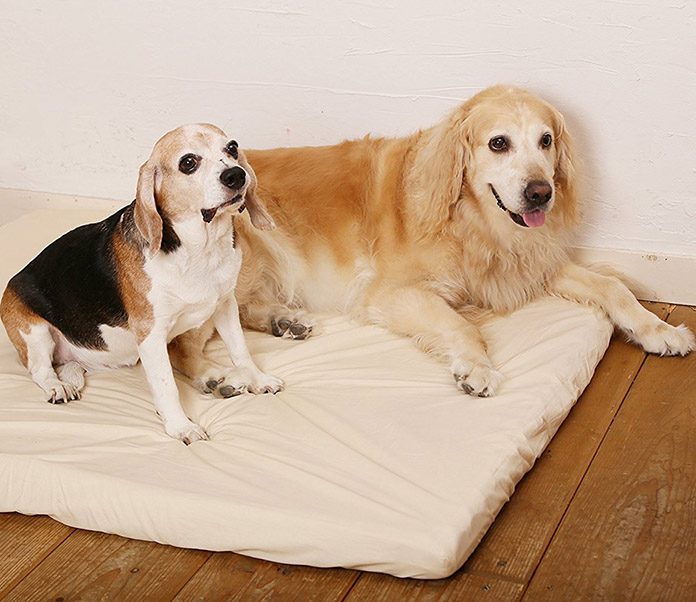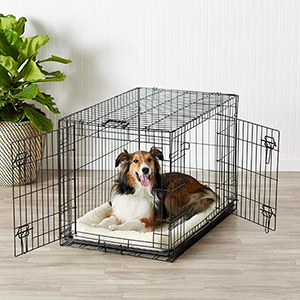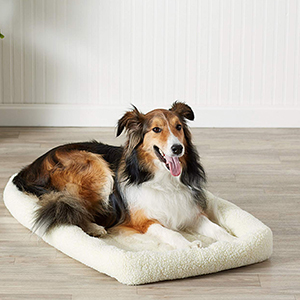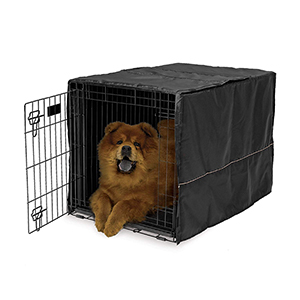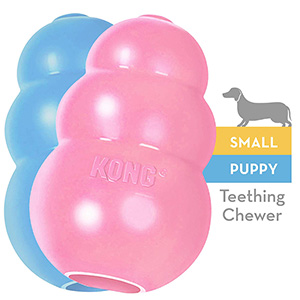Just like humans, puppies need a safe, comfortable place to sleep at night in order to get good rest. Crate training your puppy is a popular and beneficial option. By teaching your puppy to sleep in a crate, they will learn to think of their crate as their sanctuary, somewhere they can go to rest and be content on their own.
Bringing a new puppy into your home is an exciting time. As you’re purchasing the necessary supplies and puppy food, there’s one consideration you don’t want to forget: planning where your puppy will sleep. Puppy crate training can be a good option, and one that will benefit your pup and family throughout their life.
Why You Should Crate Train Your Puppy
Dogs need to have a space of their own, a sanctuary where they can be alone and rest. If you teach your puppy to think of their crate as this sanctuary when they’re young, they will continue to retreat to it even once they’re grown. Crate training can also help make housetraining your puppy easier by minimizing the chance for accidents – dogs don’t want to eliminate where they sleep!
How to Choose the Right Size Crate for Your Puppy
Consider the size your dog will be once they’re full-grown. Getting a large crate for a small puppy can seem counterintuitive, but as your puppy grows the amount of personal space they need increases as well. Be sure to choose a crate that will allow your pup plenty of room to comfortably stand, turn around and lie down once they’re a full-size dog.
Where to Put Your Puppy’s Crate
You should plan to put your puppy’s crate in a quiet area of your home where your puppy can comfortably sleep, but also a place where they can be included in daily family life. Consider putting your puppy’s crate in a quiet corner of your kitchen or living room.
What to Put in Your Puppy’s Crate
You may choose to put a bed in your dog’s crate, but keep in mind they might chew on it and rip out the stuffing. Many pet parents choose to place a blanket in their dog’s crate instead. Whether you place a dog bed or old blanket in their crate, it’s important to provide something warm and soft for your dog to sleep with.
How to Crate Train Your Puppy in Four Steps
Step 1
When you first begin to crate train your puppy, place the crate where you intend to keep it in your home and leave the door open. Place toys, treats or food in the crate to entice your puppy to enter it voluntarily. Provide positive reinforcement and praise when they go inside the crate. Continue this process as long as it takes for your puppy to get comfortable entering the crate voluntarily.
Step 2
The next step is to initiate short confinement sessions in the crate with your puppy inside. Make sure your puppy has played or exercised and eliminated before their first confinement session. Put your puppy in the crate along with a few treats or toys and close the door.
Step 3
Stay in the room with your puppy to monitor their reaction. It’s likely they’ll whimper or whine a bit. This behavior is to be expected, so don’t release them. Responding to your puppy’s vocalizations by letting them out of the crate will impede the crate training process.
Step 4
Let your puppy out of the crate after five minutes. Continue this process, increasing the amount of time you leave your puppy in the crate each time, as well as increasing your distance away from your puppy to the point where you are no longer in the same room or at least are no longer visible.
What Not to Do When Puppy Crate Training
- Don’t force your puppy into the crate. Pushing or pulling them into the crate against their will builds a negative association in your puppy’s mind. They will see the crate as punishment or banishment.
- Don’t use the crate as punishment. When your puppy exhibits bad behavior, don’t lock them in their crate as punishment. This won’t teach them the lesson you’re trying to convey and will create a negative association in your pet’s mind about their crate. (Crate confinement can, however, be used as a tool to help avoid destructive behaviors or prevent your pet from getting into things they shouldn’t when you’re not there to supervise them.)
- Don’t reward your puppy upon letting them out of the crate. Doing so will train your puppy to think being out of the crate is the reason you’re giving praise or treats. This can make it more difficult for them to be content during their time in the crate.
- Don’t put your dog in their crate when you want to be lazy. Daily play and exercise are important for dogs and puppies, even if they are content to spend time in their crate. Make sure to give your dog time where they can be active and run around.
- Don’t keep your puppy in their crate for a long period of time. Keeping your puppy in their crate for too long can make your pet miserable and increase the risk of them having an accident inside the crate. Your puppy will be able to spend more time in the crate as they grow older, but don’t keep them confined to the space too long or they may begin to resent it.
If you follow these tips and tricks for crate training your puppy, you’ll likely find that your puppy sleeps comfortably through the night and will enjoy the space you’ve given them as their own for years to come.














